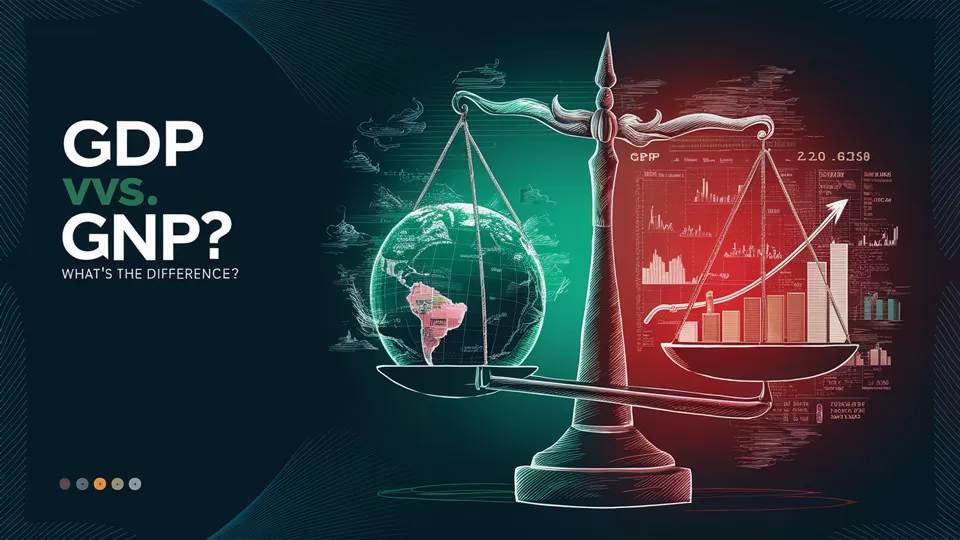GDP vs. GNP: An Overview
Gross Domestic Product (GDP) and Gross National Product (GNP) are two key metrics used to gauge a country’s economic performance. Both measure the total market value of goods and services produced over a specific period, but they do so in slightly different ways.

- GDP measures the value of finished goods and services produced within a country’s borders, regardless of who produces them.
- GNP measures the value of finished goods and services produced by a country’s citizens, no matter where they are in the world.
Understanding these differences is crucial for investors, policymakers, and economists as they provide insights into different aspects of a nation’s economic health.
Key Takeaways
- GDP: Reflects economic activity within a country’s borders.
- GNP: Reflects economic activity by a country’s citizens, both domestically and abroad.
- The U.S. uses GDP to compare economic performance with other countries.
- Gross National Income (GNI) is often used interchangeably with GNP.
Gross Domestic Product (GDP)
What is GDP?
GDP is the most common indicator used to measure the overall health and size of a country’s economy. It sums up the market value of all goods and services produced domestically.
Components of GDP:
- Consumption: Spending by households on goods and services.
- Government Spending: Expenditures by the government for public services and infrastructure.
- Business Investment: Spending by businesses on capital goods.
- Net Exports: The value of a country’s exports minus its imports.
Real vs. Nominal GDP:
- Nominal GDP: Measures the value of goods and services at current prices, without adjusting for inflation.
- Real GDP: Adjusts for inflation, providing a more accurate reflection of economic growth over time.
Why is GDP Important?
- Economic Health: Rising GDP indicates economic growth, while falling GDP may signal economic trouble.
- Policy Making: Helps governments draft economic policies.
- Investment Decisions: Used by investors to assess economic performance and potential investment opportunities.
Gross National Product (GNP)
What is GNP?
GNP measures the market value of goods and services produced by a country’s citizens, both within its borders and abroad. It reflects the economic contributions of a nation’s citizens globally.
Calculating GNP:
GNP is calculated by adding consumption, government spending, business investment, net exports, and net income from abroad (income earned by citizens and businesses from foreign investments minus income earned by foreigners from domestic investments).
Why Use GNP?
GNP is useful for understanding the global economic engagement of a country’s citizens and businesses. It highlights how nationals are contributing to the economy, regardless of their physical location.
Comparing GDP and GNP
Example of GDP vs. GNP:
- United States: GDP measures all economic activity within the U.S., while GNP includes income earned by U.S. citizens abroad and excludes income earned by foreign residents within the U.S.
- Saudi Arabia: As a major oil exporter, Saudi Arabia’s GNP is higher than its GDP due to significant income from overseas oil businesses.
Practical Uses and Implications
When is GNP More Useful?
GNP is particularly useful for assessing the economic impact of overseas activities by a country’s citizens, such as expatriates and multinational corporations.
GDP vs. GNP in Practice:
- United States: The U.S. shifted from GNP to GDP in 1991 to align with international standards.
- Hong Kong: As an export-oriented economy, Hong Kong’s GNP significantly exceeds its GDP due to extensive overseas business operations.
Conclusion
Both GDP and GNP are vital economic metrics, each offering unique insights. GDP provides a snapshot of domestic economic activity, while GNP offers a broader view of economic contributions by a country’s citizens globally. Understanding the distinctions between these metrics helps in making informed decisions, whether for policy-making, investment strategies, or economic analysis.
By keeping an eye on both GDP and GNP, stakeholders can gain a comprehensive understanding of a country’s economic health and its citizens’ global economic engagement.

Roger Varley is a seasoned financial expert with over two decades of experience and an MBA from Harvard Business School. He specializes in commodity trading and portfolio diversification, and has authored several bestsellers that simplify complex financial concepts for investors. Residing in New York City, Roger continues to share his knowledge through his writing and lectures at financial conferences worldwide.



